Relays are essential components in electrical circuits, acting as a switch that opens and closes to control the flow of electricity. They are widely used in various applications, from simple household appliances to complex industrial systems. One of the most critical specifications to consider when selecting a relay is its voltage rating. Understanding the relay voltage rating is crucial to ensuring the proper functioning, safety, and reliability of the entire electrical system.

What is Relay Voltage Rating? The voltage rating of a relay refers to the maximum electrical potential (voltage) that can be applied to its contacts without causing damage to the relay or the connected system. The voltage rating is typically defined in two ways: the coil voltage and the contact voltage. Coil Voltage Rating: The coil voltage rating indicates the voltage required to energize the relay coil, which in turn activates the switching mechanism. It is crucial to match the coil voltage with the power supply’s voltage to ensure the relay operates correctly. For instance, a relay with a 12V coil rating should only be powered by a 12V DC supply. If the coil is over-volted, it may burn out, while under-voltage might prevent the relay from operating.